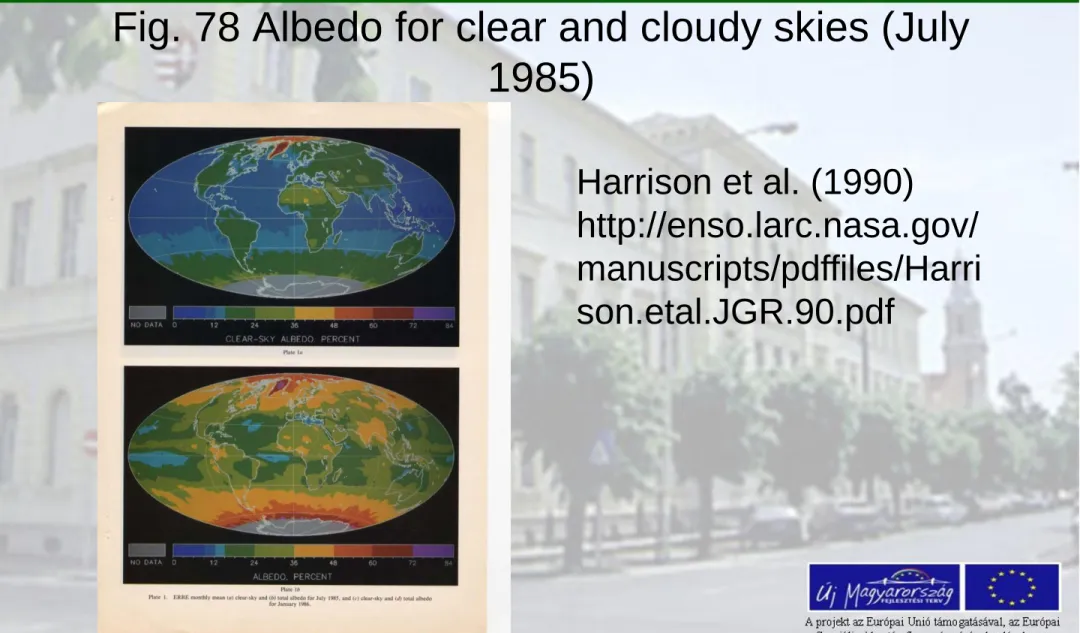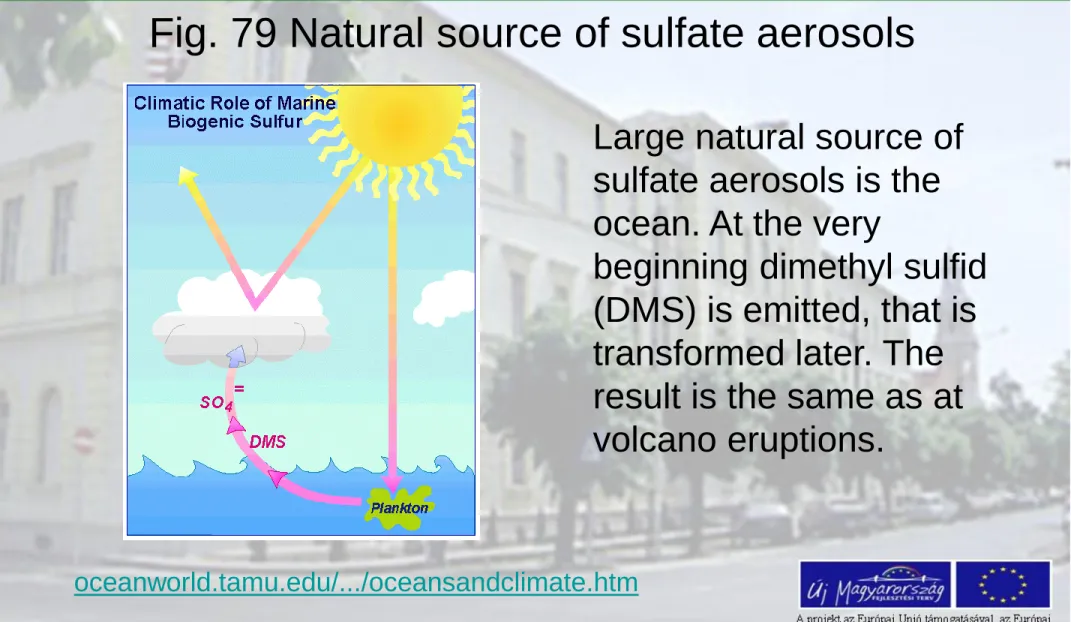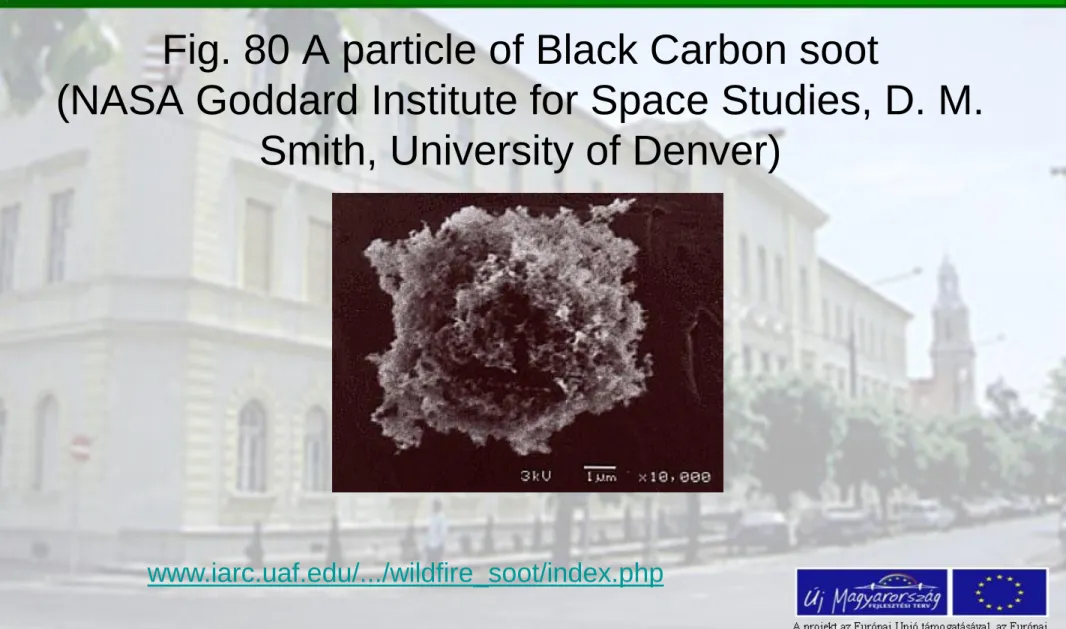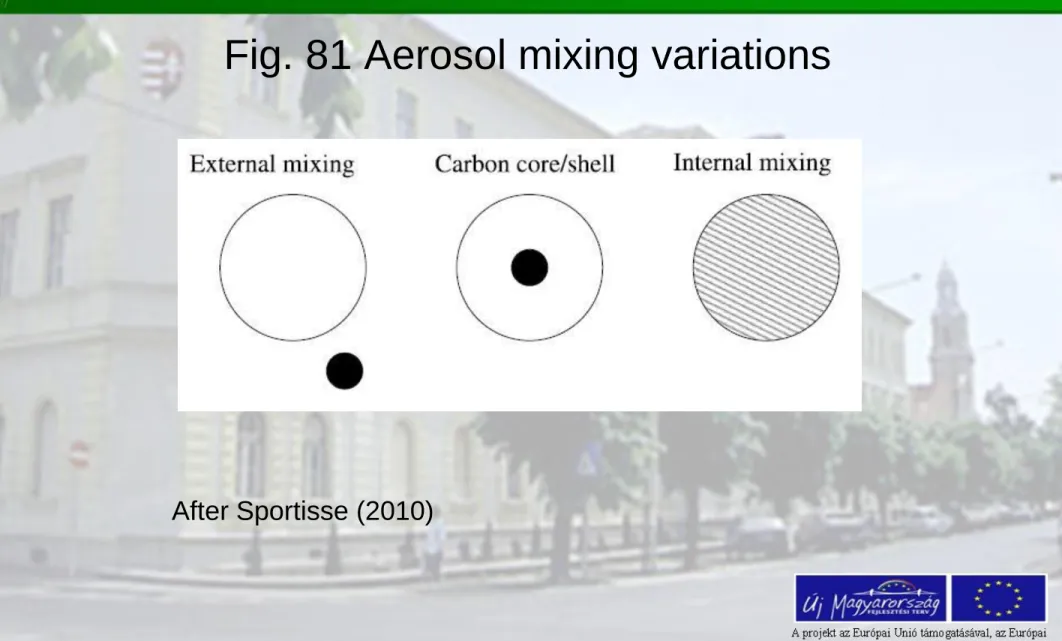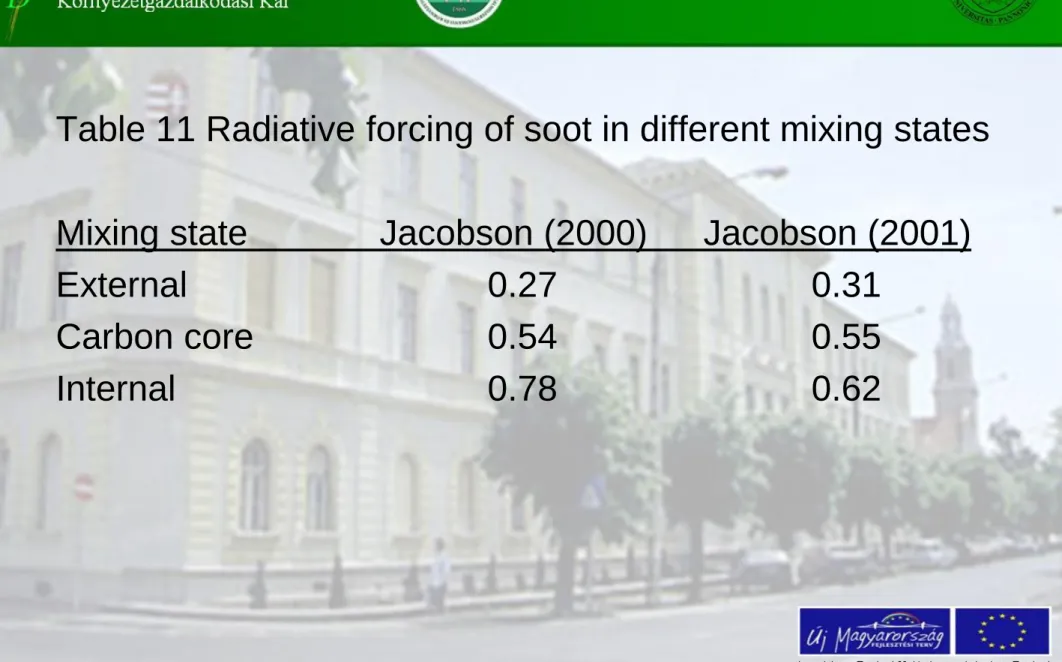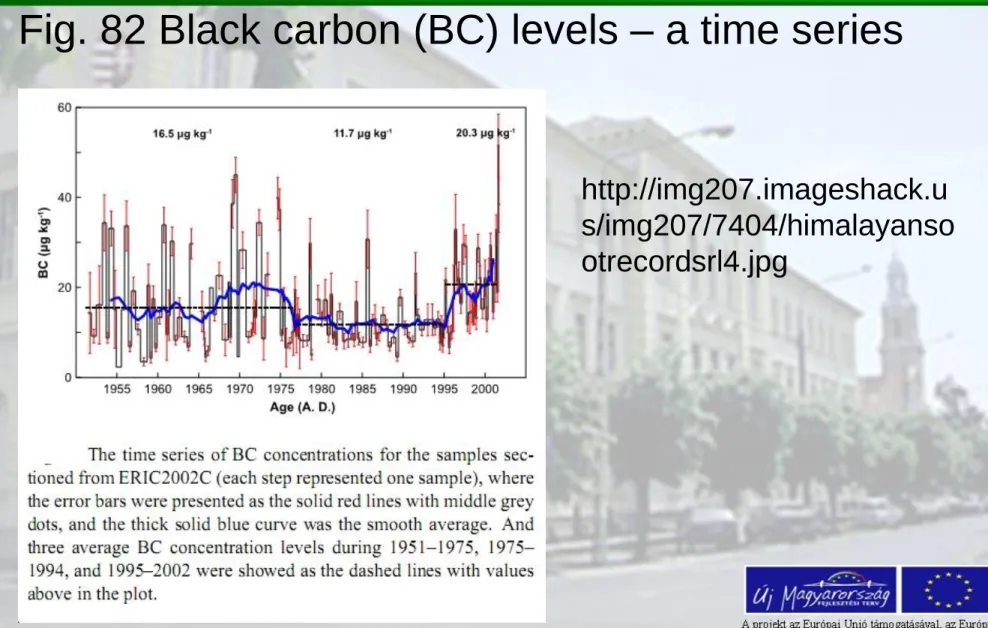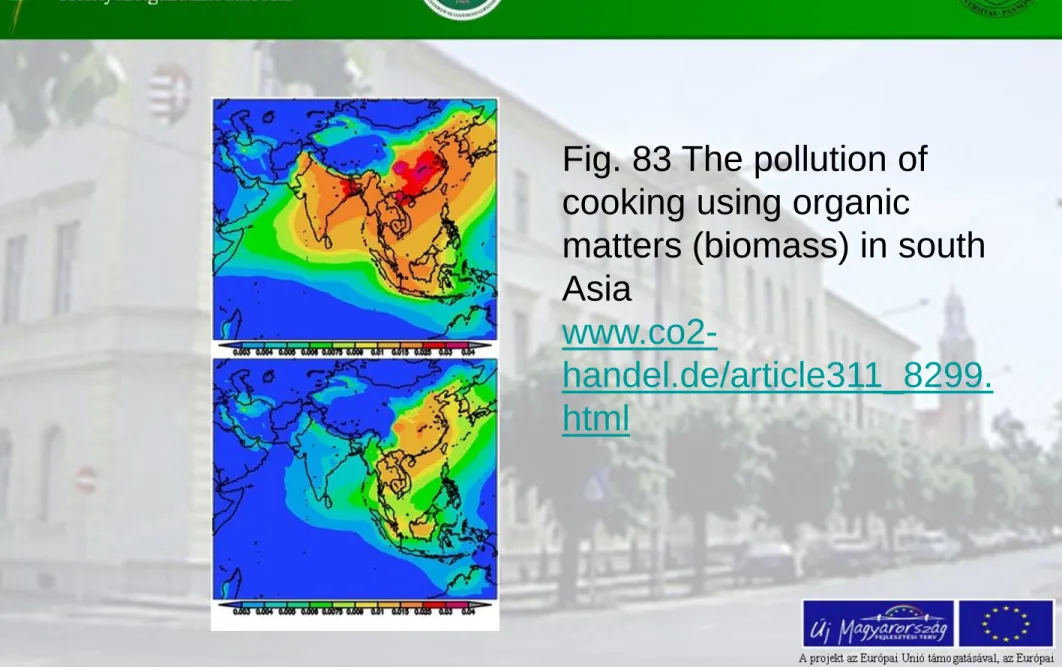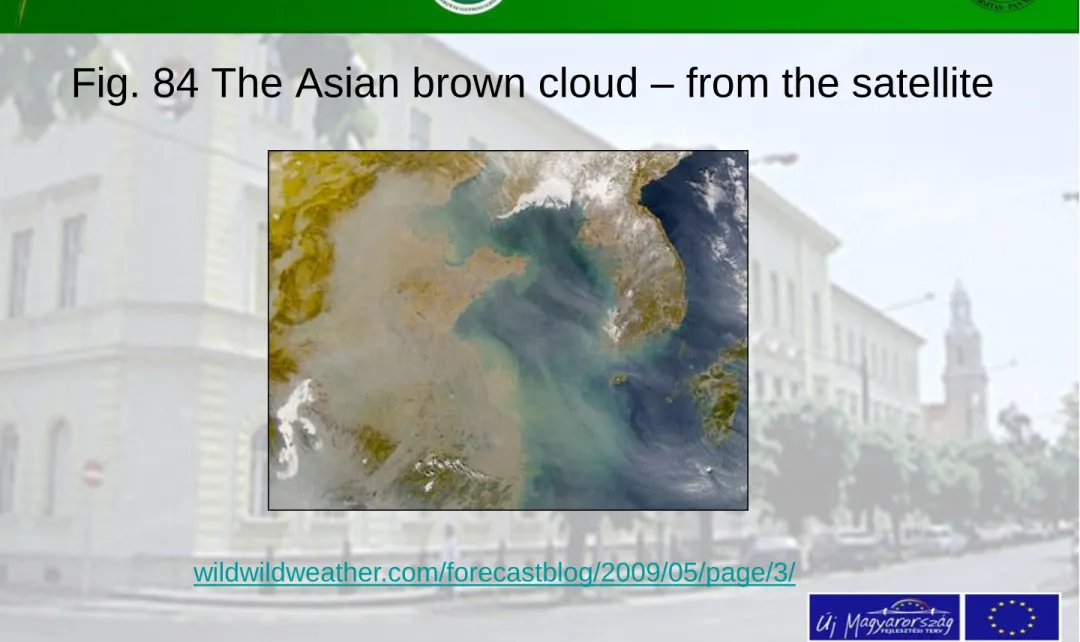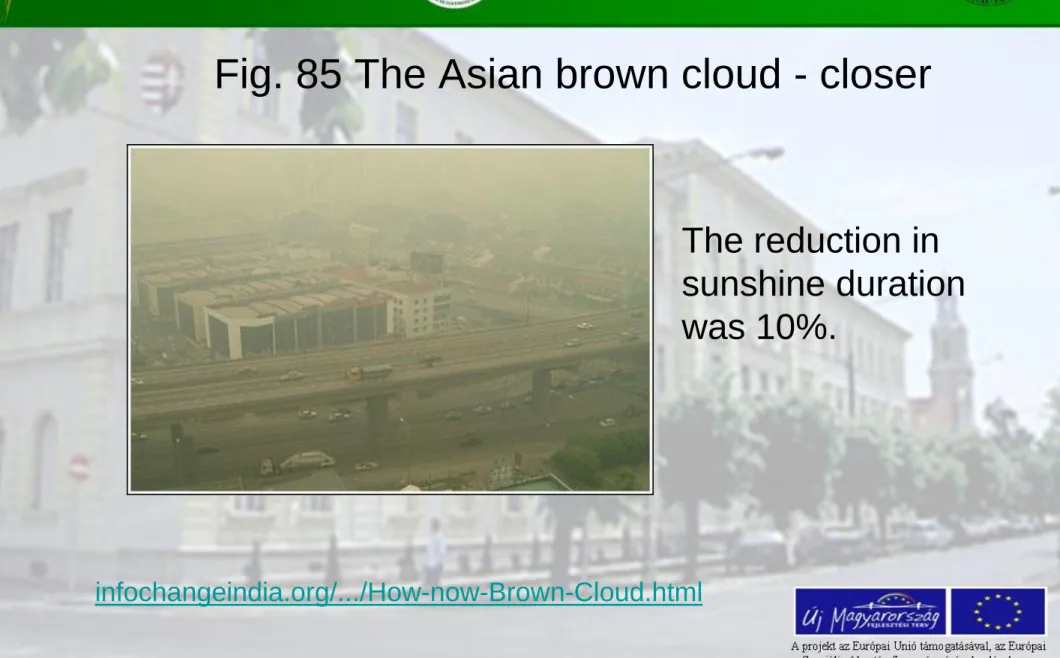Tananyag fejlesztés idegen nyelven
Prevention of the atmosphere
KÖRNYEZETGAZDÁLKODÁSI AGRÁRMÉRNÖKI MSC
(MSc IN AGRO-ENVIRONMENTAL STUDIES)
Global warming and aerosols;
facts and dilemmas
Lecture 10
Lessons 28-30
Lesson 28
Direct impact of clouds and aerosols on global warming process. The whitehouse
effect
The uncertainties in assessing the global warming;
impact of
- the aerosols and - the clouds
• Compare the size of an atom to aerosols!
The order of the atom is 10−10 m (10−4 μm or 0.1 nm; the Bohr radius is 0.5292×10−10 m). The size of an atomic nucleus is of the order of 10−14 m (10−8 μm or 10−5 nm).
The diameter of an aerosol is only some nanometers (or 10−2 μm); a hundred times or more large than an atom. An
aerosol may contain a few number of atoms or clusters of atoms.
Clouds – direct effect
Both climate and climate change are largely determined by cloud properties through the radiative forcing of clouds.
Lack of information on the effect of clouds on the Earth- atmosphere radiation budget hinders the construction of proper climate evaluation and projections.
1. The influence of clouds on radiative forcing is two-fold.
The constituents of clouds scatter the incoming radiation contributing to the albedo. The approximated
contribution depends on cloud member’s diameter. Thin stratus has an albedo of about 0.2 ; therefore the albedo of a cumulus is 0.9. In average the increment in albedo value is about the half of the total size (0.15).
Fig. 78 Albedo for clear and cloudy skies (July 1985)
Harrison et al. (1990)
http://enso.larc.nasa.gov/
manuscripts/pdffiles/Harri son.etal.JGR.90.pdf
2. Increased scattering for short wave radiation is observed in clouds. At the same time the increment in emissivity and absorptivity of long wave radiation may also be found. This later one is the reason why the clouds act as greenhouse gases. Their contribution to radiation balance is assumed to be 25-35 Wm-2.
The totaled impact (1-2) will be cooling, as the radiation decline from albedo growth is two times higher (-50 Wm-
2) than that of the impact of clouds as warming
greenhouse gases. The cooling effect is large over the mid-and high-latitude oceans, with the values of reaching -100- -150 W/m2.
The monthly averaged longwave cloud origin radiation
forcing reached maximum values of 50 to 130 W/m2 over the convectively disturbed regions of the tropics.
Uncertainties may arise due to excluded CO2 change.
Regarding this topic, the earlier observations mentioned that the shortwave and longwave components of cloud induced radiative forcing are about ten times as large as those for a CO2 doubling (after Science). Hence, small changes in the cloud-radiative forcing fields can play a significant role as a climate feedback mechanism
(oceanic cooling and continental glaciation).
A feedback – impact of clouds
Higher global radiation causes warming of the surface (the ocean and ground). The increased temperature
enhances the evaporation and more clouds will be formed. The larger cloud cover increases the albedo, producing more intense cooling.
Oppositely, the high cloudiness results more rain
decreasing the cloud lifetime and declines the albedo.
The clouds, for infrared radiation, act as greenhouse
gases. But to have more precise results, height of the clouds should also be taken into account. Cirrus clouds (highest level ones) have a warming impact.
Direct impact of aerosols
• The quantity of the atmospheric aerosol influences the radiation budget. After volcano eruption, the measured yearly mean temperatures fall, due to increased sulfate concentration of the stratosphere. This is registered as the whitehouse effect.
• Our sample is the Pinatubo volcano, which erupted in 1991. In the first year the mount emitted 10 Tg of sulfur into the air. A few months after eruption the amount of atmospheric sulfur content still reached the 6 Tg.
• The yearly mean air temperature of 1992 declined with 0.5 K (global level!).
Fig. 79 Natural source of sulfate aerosols
Large natural source of sulfate aerosols is the ocean. At the very
beginning dimethyl sulfid (DMS) is emitted, that is transformed later. The result is the same as at volcano eruptions.
oceanworld.tamu.edu/.../oceansandclimate.htm
• The emitted sulfate aerosols used to cause a maximum radiative forcing of about -30 - -40 Wm-2 just after the
larger volcano’s emission. Later on this value depresses until -0.1 Wm-2.
• In general, after a larger volcano eruption the cooling of air temperature used to be some tenth of degrees
centigrade in annual mean.
• Evaluation of the direct influence of aerosols on albedo is circumstancial. We should take into consideration
some other factors as well. The ratio of the human
induced impact is assumed to be one quarter (25%) of the total change.
Exercise
• Calculate the contribution of aerosols to global albedo using the data below!
Needed basics:
– total optical depth: τ 0.12 (mean value above oceans)
– ratio of supposed fraction of radiation β = 23%
(assumed radiation scattered back to space)
The incident radiation, I , has to be divided to the following parts:
First is the amount of radiation that is transmitted
exp(−τ)I,
The second is scattered
(1 − exp(−τ ))I .
The third is the fraction β of the scattered radiation that is reflected back to space. Than the albedo A1:
A1 = β(1 −exp(−τ)) ~ βτ.
The final result will be A1 ~ 0.026.
Lesson 29
Dilemmas in global warming. Impact of black
carbon
Dilemmas
• Neglecting some of the other factors modifying the albedo size, the final result for the aerosol effect is approximately -0.85 Wm-2.
1. The local sulfate pollution may equalize the effect of today’s global warming. The local pollution may emit a huge amount of SO2, that is transformed in the air as sulfate aerosols, and they are cooling the closed
surroundings. The process of increasing the sulfate
concentration of the air may court environmental danger.
For example an adverse effect may be the ozone
destruction of the stratosphere due to the role of sulfate in chemical processes.
2. The next risk seems to be the needed amount of SO2
used during the process of cooling the atmosphere. The compensation of doubled CO2 impact requires at about 55 Tg SO2 yearly.
After calculations of Crutzen (2006) the artificial emission of 1 Tg SO2 costs 25 billion $. Planning this experiment, we should consider the life time of the SO2 also, that varies from 1 to 2 years, depending on the actual SO2
concentration.The yearly amount necessary to inject to the air is than 2.5 to 5 Tg S. Considering the local
ambient air quality improvements also, the total cost will be 60 to 120 billion $. Expensive…
Influence of black carbon (aerosol)
Impact of aerosols depends on many factors: size,
chemical composition and the mixing state. This latter one means the way of the appearance of the particle in the air. (The water content of the atmosphere also
modifies the air radiative properties – aerosol!)
• Black carbon particles originate from incomplete
combustion of materials. Earlier publication shows that the assessment of soot role seems complicated. It is widely known, that the effect of black carbon for Earth radiation budget has of primary importance. Direction of change in radiative forcing is always positive because the soot absorbs the infrared radiation.
Fig. 80 A particle of Black Carbon soot
(NASA Goddard Institute for Space Studies, D. M.
Smith, University of Denver)
www.iarc.uaf.edu/.../wildfire_soot/index.php
• The amplitude of radiation force change depends on soot-air position and holds very high uncertainty!
There are three possibilities regarding the mixing of the black carbon.
- Internal mixing means well distributed soot in the air;
the particles are mixed completely
- Just the opposite can be found in external mixing, where the soot can be found „outside”.
In the carbon core model the black carbon is in the middle and it is surrounded by other organic and non-organic compounds.
Fig. 81 Aerosol mixing variations
After Sportisse (2010)
Table 11 Radiative forcing of soot in different mixing states
Mixing state Jacobson (2000) Jacobson (2001)
External 0.27 0.31
Carbon core 0.54 0.55
Internal 0.78 0.62
• Following the data of the Table 11, the impact of black carbon might have been underestimated until now.
Earlier the external mixing was widely applied in
modeling. The highest radiative forcing values were obtained when the carbon shell model was used. If we assume this approximation as a real one, the second larger contributor to the greenhouse effect may be the black carbon itself.
The liquid water is the another direct factor that may
change the radiative forcing. The larger the liquid water content in the air, the larger the size of aerosols, that impacts the radiative forcing as well.
• Earlier investigators concluded that soot has twice as much effect as CO2 on global surface air temperature. It follows that the black carbon may also contribute to the thinning of sea ice and glacial melting.
A study on the effects of very small amounts of soot on fresh snow showed a reduced albedo, the reflective quality of snow, of about 30% and a 50% increase in melting compared to clean fresh snow. As the soot particles absorb visible light, most of which is not
absorbed by snow or ice, they convert the absorbed light into heat and the above surfaces begin to melt.
• It is instructive how researcher imagine the
consequences of growing soot attendance. As these particles reduce snow and ice albedo and increase
melting, the researchers hypothesize that boreal wildfire soot in the Pan Arctic can be an important natural
contributor to the reduction of sea ice and accelerated glacial melting.
Between 25 and 35 percent of black carbon in the global atmosphere comes from China and India, emitted from the burning of wood and cow dung in household cooking.
Developed countries, included Europe due to diesel fuel for transportation also emits huge amount of soot.
Fig. 82 Black carbon (BC) levels – a time series
http://img207.imageshack.u s/img207/7404/himalayanso otrecordsrl4.jpg
Fig. 83 The pollution of cooking using organic
matters (biomass) in south Asia
www.co2-
handel.de/article311_8299.
html
• On the Fig. 83 results of the cooking with wood and the cow dung are illustrated as in soot emission. The authors applied the method of aerosol optical depth. The basis of the evaluation is measuring the quantity of pollutants in the air by the relative ability of light to penetrate through them.
• The upper image introduces an environmental state after the serious pollution happened in 2004. It also continued during 2005.
• The bottom picture represents the effects of biofuel cooking has been effectively removed.
Source: Scripps Institution of Oceanography
Lesson 30
Indirect influence of atmospheric aerosols.
The ABC, their impact. Size of danger.
Dilemmas again…
Indirect effect of aerosols
• This impact comes from the fact, that the aerosols act as condensation nuclei in forming precipitation.
Effectiveness of aerosols in precipitation formation depends of the size of particles.
• Before the precipitation is falling out from the
atmosphere, clouds are generating. The clouds impact the radiative forcing of the atmosphere.
• Due to this differred addressing the above influence is supposed an indirect impact connecting to aerosols.
ABC – atmospheric brown clouds
Physical relations between aerosol size and albedo are:
- Albedo of clouds is decreasing regarding to the raindrop size
- Albedo of clouds is increasing with drop number densities
This latter property is known as the Twomey effect.
In the close past investigators showed that there is a
constant plume pollution in Asia (Indian ocean). Later on this urban origin particulate matter forming the brown
colored clouds was also observed in other places of the world.
• The Asian brown cloud that is an air
layer containing air pollutant covers parts of South Asia, more exactly the northern Indian Ocean, India and Pakistan. Viewed from satellite photos, the cloud appears as a giant brown stain hanging in the air over much of South Asia and the Indian Ocean every year between January and March, possibly also during earlier and later
months.
• It is connected to rain free period, where no or less water is available to wash out the air.
• Major impact of cloud is on health. The 2002 study indicated nearly two million people die each year in India alone from conditions related to the brown cloud.
• See Fig. 84-85!
Fig. 84 The Asian brown cloud – from the satellite
wildwildweather.com/forecastblog/2009/05/page/3/
Fig. 85 The Asian brown cloud - closer
The reduction in sunshine duration was 10%.
infochangeindia.org/.../How-now-Brown-Cloud.html
Other related places in the world:
- North Atlantic Ocean (North Atlantic plume), over north- eastern Europe,
- over the Pacific Ocean (Chinese plume) and
- over the South Atlantic Ocean (biomass burning plume from the Amazonian forest)
The thickness of these clouds is up to 3 km. They contain mainly particulates. The wind transports this
contaminants.
Impacts of the clouds are:
- negative radiative forcing of the clouds (in Asia) of about + 20 to +40 Wm-2.
• On the touched places the precipitation events are modified and the whole water cycle may also be disturbed. More rainfall is waited.
• The reason of this disturbance is the alteration of the cloud life cycle, mainly during the dry season.
• Retreat of the Himalayan glaciers and snow packs (+BC) Contradictory imaginations, dilemmas
- Increased aerosol number results in higher cloud drop number,
- this induces decline in efficiency of rainfall increasing in the cloud life time.
One possibility
As a result of the reduced precipitation, a decline of snow falls can be observed.
Another possible way
More cloudiness causes growing in solar radiation
reflection. The more the reflected radiation the lower the air temperature is. This declined temperature (cooling) rises the possibility of snow formation (physical effect).
The global impact, as far as the snow falls are concerned, is then ambiguous.
